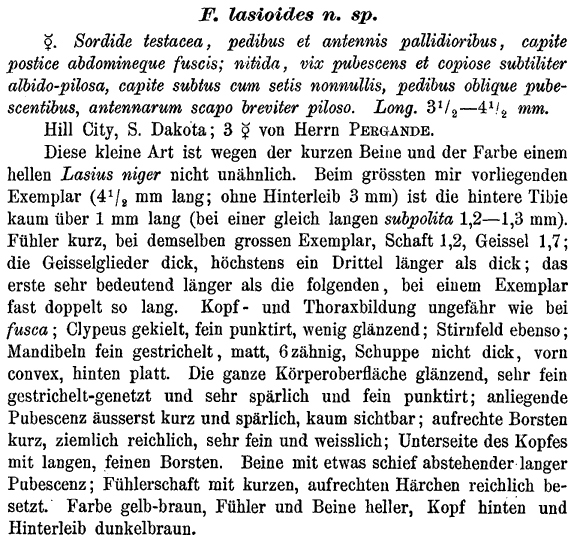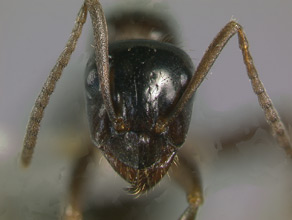- Identification
- Slightly smaller than medium-sized workers. Their shiny integument and smaller size place these Formica ants in the neogagates species group. Formica lasioides workers vary from concolorous light yellowish-brown, to dark brown or black, or with individual variation in color that spans the range from lighter yellowish-brown (on the head, mesosoma, petiole and appendages) to darker brown/black (gaster). One character that differentiates this species from other neogagates on the Reservation is the presence of standing hairs on the scapes.
- Biology
- Generally an open habitat species that can be locally abundant in fields and grasslands. It is occasionally found in woodland areas. Colonies are small, consisting of a few hundred workers, with one queen. Nest entrances may be under a covering object, marked by a small soil crater or, less often, are unmarked openings in the ground.
- additional biology notes...
- Distribution
- Range
- Nearctic. United States and Canada. East to west across the northern US and southern Canada and in the southwestern US down ot California, New Mexico and Arizona.
- Navajo Reservation Records
- Collection records being processed.
- Additional Notes
- This species faces trouble from other ants on two fronts. First their colonies can be raided by slave making sanguinea group Formica species. Second they may be parasitized by other Formica species that have queens that initiate nests by invading heterospecific Formica colonies.
- Formica lasioides foragers are omnivores. Workers move quickly and are can be adept at avioding being collected.
- In the western part of its range this species name is likely just a convenience. There are believed to be a number of unnamed neogagates species with standing hairs on their scapes.
- Etymology
- Morphological. A reference to the general appearance of the workers; Lasius + oeides = like

- Literature
- Emery, C. 1893. Beiträge zur Kenntniss der nordamerikanischen Ameisenfauna. Zoologische Jahrbücher, Abteilung für Systematik, Geographie und Biologie der Tiere. 7:633-682.
- A note about these publications. The literature cited here is not meant to be an exhaustive list of papers published about this species.
Page authored by David Lubertazzi and Gary Alpert


